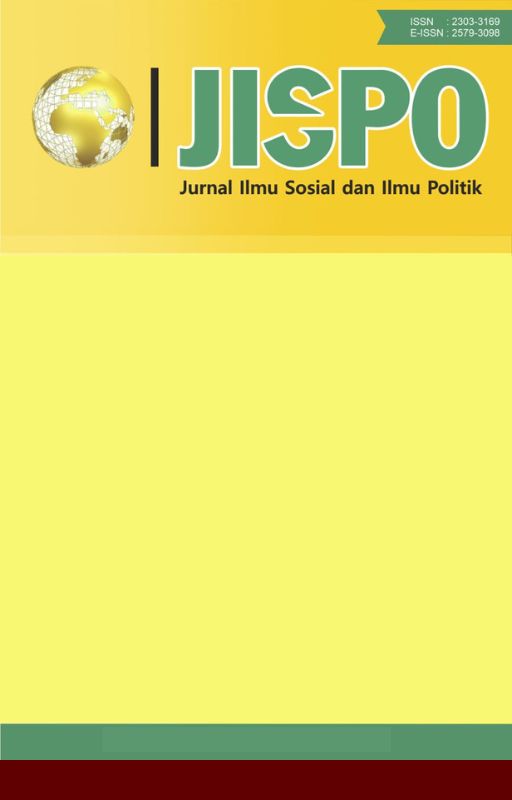KEBIJAKAN PENGEMBANGAN DESTINASI PARIWISATA CIANJUR SELATAN DI KABUPATEN CIANJUR JAWA BARAT
DOI:
https://doi.org/10.15575/jispo.v9i1.5857Keywords:
policy strategy, tourism development, local government.Abstract
Tourism has grown spectacularly as a mainstay sector of various countries in gaining foreign exchange and economic growth, including Indonesia. Likewise for one of the regions in Indonesia, namely Cianjur Regency which has a variety of interesting tourist attractions and is visited by tourists such as Cipanas. Tourism in Cianjur Regency is not only North Cianjur but also in South Cianjur has very potential tourism potential. But unfortunately, the management is not optimal so that its potential has not been explored. Therefore, this study will examine the extent of Cianjur Regency tourism policy in developing South Cianjur tourism. This study uses descriptive analysis method to explore the object under study. The type of data used is data in the form of interviews and secondary results. The results of the study show that the policies that have been implemented have not been able to improve the performance of the tourism sector optimally. Some indicators that have not been optimal include infrastructure development, tourism promotion, and commitment to policy implementation.
References
Biederman, P. S., & Biederman, P. S. (2008). Travel and tourism: An industry primer. Pearson/Prentice Hall.
Cresswell, J. W. (2009). Research Design: Qualitative, Quantitative, and Mixed Methods Approaches. USA: Sage Publication.
Dinas Kebudayaan dan Pariwisata Kabupaten Cianjur. (2012). Profil Pariwisata Kabupaten Cianjur.
Instruksi Presiden Republik Indonesia Nomor 16 Tahun 2005 tentang Kebijakan Pembangunan Republik Indonesia.
Instruksi Presiden Republik Indonesia Nomor 16 Tahun 2005 tentang Kebijakan Pembangunan Kebudayaan dan Pariwisata
Judisseno, R. (2017). Aktivitas dan Kompleksitas Kepariwisataan: Mengkaji Kebijakan Pembangunan Kepariwisataan. Jakarta: Gramedia Pustaka Utama.
Kajian Kawasan Strategis dan Kawasan Pengembangan Pariwisata Cianjur Selatan. (2017). PT. Puri Dimensi
Kodyat, R. A. (2001). Statistik Induktif Terapan. Yogyakarta: BPFE UGM
Mill, R. C., & Morisson, A. M. (1985). The Tourism System: An Introductory Text. Englewood Cliff: Prentice Hall-Inc
Mulyana, Y. (2017). Model Kebijakan Peningkatan Laporan Kematian dalam Administrasi Kependudukan dan Catatan Sipil di Kabupaten Bandung Barat. Sosiohumaniora, 19(2), 140-148.
Organisasi Perburuhan Internasional. (2011). Mengukur Lapangan Kerja dalam Industri Kepariwisataan lebih dari Neraca Satelit Pariwisata: Studi Kasus Indonesia
Peraturan Daerah Provinsi Jawa barat Nomor 15 Tahun 2015 tentang Rencana Induk Pembangunan Kepariwisataan Provinsi Jawa Barat Tahun 2015-2025
Peraturan Daerah Kabupaten Cianjur No. 01 Tahun 2017 tentang Rencana Induk Pembangunan Kepariwisataan Kabupaten Cianjur dan Penyelenggaran Kepariwisataan
Putra, I. F. (2012). Analisis Daya Saing dan faktor-Faktor yang Mempengaruhi Pariwisata Kabupaten Cianjur. Bogor: IPB.
Suardana, I. W. (2016). Analisis Kebijakan Pengembangan Pariwisata: Intervensi Melalui Kebijakan Pariwisata Berkelanjutan di Bali. Universitas Udayana.
Suwantoro, G. (2004). Dasar-dasar Pariwisata. Yogyakarta: Andi.
Swanson, J. R., & Edgell Sr, D. L. (2013). Tourism policy and planning: Yesterday, today, and tomorrow. Routledge.
Trisnawati, R., Wiyadi, W., & Priyono, E. (2008). Analisis Daya Saing Industri Pariwisata untuk Meningkatkan Ekonomi Daerah:(Kajian Perbandingan Daya Saing Pariwisata antara Surakarta dengan Yogyakarta). Economic Journal of Emerging Markets, 13(1), 61-70.
Undang-Undang Nomor 10 Tahun 2009 tentang Kepariwisataan.
Wahyuningsih, & Dwi, R. (2011). Membangun Kpercayaan Publik Melalui Kebijakan sosial Inklusif. Jurnal Ilmu Sosial dan Ilmu Politik, 15(1), 29-40.
World Tourism Organization. (1995). Concepts, Definitions, and Classifications for Tourism Statistics. World Tourism Organization, Madrid.
Yoeti, O. (2008). Ekonomi Pariwisata: Introduksi, Informasi, dan Impelementasi. Kompas Jakarta.
Downloads
Published
How to Cite
Issue
Section
Citation Check
License
Authors who publish their manuscripts in JISPO agree to the following terms:
- Authors retain copyright and grant the journal right of first publication with the work simultaneously licensed under a Creative Commons Attribution-ShareAlike 4.0 International License that allows others to share the work with an acknowledgment of the work's authorship and initial publication in this journal;
- Authors are able to enter into separate, additional contractual arrangements for the non-exclusive distribution of the journal's published version of the work (e.g., post it to an institutional repository or publish it in a book), with an acknowledgment of its initial publication in this journal; and
- Authors are permitted and encouraged to post their work online (e.g., in institutional repositories or on their websites) after publication process, or prior to and during the submission process, as it can lead to productive exchanges, as well as earlier and greater citation of published work (See The Effect of Open Access).




.jpg)



